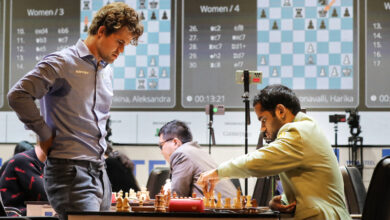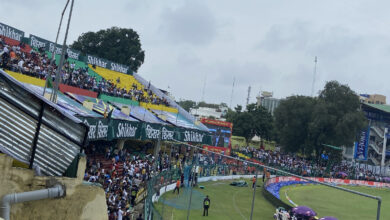Rohit Sharma’s India deserves a better venue than Kanpur’s Green Park | Cricket News

Some time back Kanpur’s Green Park, India’s pre-independence Test cricket centre, had got a much needed modern makeover. To meet the growing demand of match-day VVIP passes, a second floor was added to the pavilion complex. It had seats with the best view in the house and air-conditioned boxes with catering. So far, so good.It was all fine till the floodlights were switched on. It lifted the veil on a monumental blunder. The increased height of the stands blocked the beams traveling from the towers to the turf – covering nearly one-fourth of the playing arena with an eerie shadow of darkness.
Since the stadium was owned the state government and UP cricket association was the temporary tenants of the venue during the cricket season, the two stake-holders pointed fingers at each other. This was nothing new. Green Park, besides cricket, regularly hosts such blame games.
Official apathy spilling onto the field, plunging the stadium in semi-darkness perfectly sums up the state of cricket in a region that hasn’t been able to keep pace with the modern game.
Even today, a visit to Green Park is a throwback to the 90s – times when India’s financial muscles were shaping but not yet bulged. The coffers were filling but not overflowing. Indian cricket was in its ‘aspirational middle-class’ phase. The rickety wooden benches had been replaced plastic bucket seats but stands remained badly maintained and shaky. Ground staff still banked on the super sopper and massive manual mopping operations on rainy days.
The India-Bangladesh Test at Kanpur this week gave the fans a free trip down the memory lane, one they didn’t ask for. On match eve, the Public Works Department declared a section of the stadium unsafe. The weather-beaten structure wouldn’t be able to take the weight of ‘full to the brim’ throbbing crowd, they said. As precaution, one-third of the tickets for that one dodgy stand were withdrawn.
In a country of a billion plus that has a one-lakh capacity stadium, Green Park, with 32,000 seats, is considered a small-sized venue. It is grossly disproportionate to the city’s passion to watch Test cricket. The depleted capacity made matters worse. The paying public willing to watch a Test, a format in a perpetual do-or-die fight, was kept away because of unattended civil work. And this had happened on BCCI’s watch – the richest board that could afford to give Rs 8.5 crores to the Indian Olympic Association before the Paris Olympics.
The Kanpur Test was also a rewind to the days when cricket was exclusively on Doordarshan and messages of frustrating rainy days, about ‘khed’ (regret) about ‘kharab mausam’ (bad weather) were the norm. One full rainless day wasn’t enough to dry the Green Park outfield. The game’s newer fans, the followers of bold new India, weren’t used to sitting all day watching the turf dry.
These days most centres have an intricate network of vacuum-powered pumps and pipes below the ground. The Sub-air system is known to squeeze out close to 10,000 liters of water per minute. Many IPL and international games have re-started within 15 minutes of the rain halting. Not Green Park. Like Kanpur, it had missed the modernisation bus.
Had it not been for Rohit Sharma & Co’s kamikaze cricket – India sprinted to the fastest-ever Test innings of 285 @ 8.22 per over – UP cricket officials would have faced epic embarrassment. It was a close shave. A draw would have hurt India’s chances of reaching the World Test Championship final. All because of a world-class cricket team stuck at an archaic stadium.
One full rainless day wasn’t enough to dry the Green Park outfield. (Sportzpics)
As is the Green Park tradition, the blame game would commence. UPCA officials would try to wash their hands saying the venue was owned the state. But what stopped them from owning one for all these years? That’s when they would get tongue-tied.
UP does have a modern stadium at Lucknow but it is privately owned. It regularly holds IPL and white-ball internationals but the state association pays rent for it. Some time back, UPCA had plans to build its own stadium at Ghaziabad. Land was bought and blue prints were made. But there was a problem – a high-tension electricity line passed over the proposed stadium site. The grand project would get stalled. Officials would periodically keep floating new deadlines and keep missing it.
BCCI vice-president Rajiv Shukla was at Green Park during the Test. Presently he holds no position at UPCA but it’s easy to guess he is the boss around here. The television cameras zoom on him, he is at the award function and he is the one addressing the press conference. He had a ready defence of the ground. He called it “iconic” and “horic” and blamed Green Park’s age for its ailments.
Captain @ImRo45 collects the @IDFCFIRSTBank Trophy from BCCI Vice President Mr. @ShuklaRajiv 👏👏#TeamIndia complete a 2⃣-0⃣ series victory in Kanpur 🙌
Scorecard – https://t.co/JBVX2gyyPf#INDvBAN pic.twitter.com/Wrv3iNfVDz
— BCCI (@BCCI) October 1, 2024
“I don’t think there should be a hue and cry because when this ground was being built, the stadium was being built, then those technologies were not available,” he would say. It was a lame excuse coming from someone who has been around. Always at the right place at the right time, he was on Lord’s balcony for the 2002 Natwest final when Dada took his shirt off. He could have looked around to see what it takes to remain iconic and horic.
Lord’s has retained the old world elegance and embraced modernity, not falling into disrepair. Green Park, meanwhile, has failed on both counts as it is at the mercy of adminrators with provincial mindsets. The Indian cricket team is on a high; it really won’t suffer a second embarrassment arising out of playing at a ramshackle stadium that can’t keep its turf dry.
Send fedback to sandydwivedi@gmail.com







